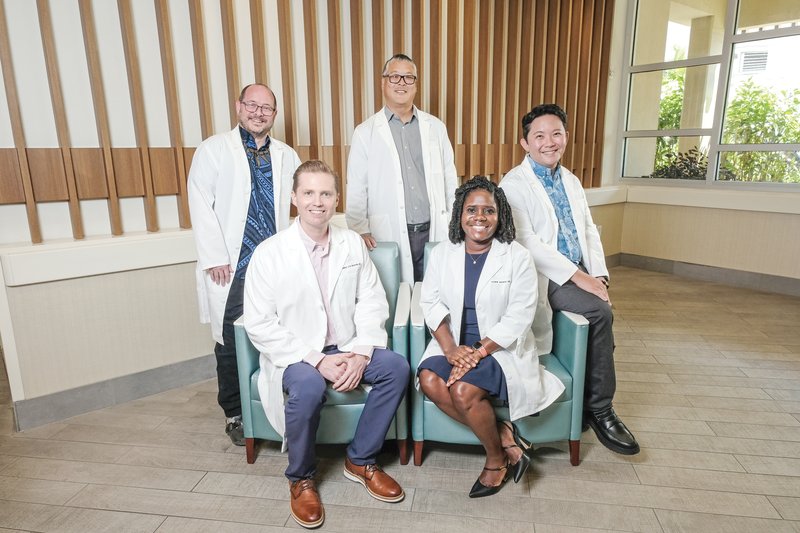Just What the Doctor Ordered

National Doctor’s Day is March 30, but the physicians at Hawai’i Pacific Health work tirelessly every day to provide the best care for their patients. | Photo by Lawrence Tabudlo
Devoted. Compassionate. Selfless. These are just a few adjectives that come to mind when describing the doctors at Hawai‘i Pacific Health (HPH).
Whether it’s bringing new life into the world by delivering babies or saving the life of someone rushed to an emergency department, HPH doctors are always ready to help — along with their amazing team of nurses, staff and administration.
In honor of National Doctors’ Day (March 30), MidWeek highlights five of those doctors — shedding light on their medical career journeys and the integral milestones they have made not just in their own lives, but in that of the hospitals they work at, the communities they live in and the patients they care for.
Dr. Andrew Baldwin
Cardiothoracic Surgeon
Hawai‘i Pacific Health Medical Group at Straub Benioff Medical Center
For Dr. Andrew Baldwin, one of the premier cardiothoracic surgeons in Hawai‘i, becoming a doctor was the only career he ever considered. His mom always knew he was going to be a doctor, and his father, a prominent heart surgeon himself, was definitely a major inspiration in whose footsteps he’d follow. But Baldwin had other reasons to pursue cardiology.
“I was always drawn to the heart because of its incredible simplicity,” says Baldwin, who completed a residency in general surgery at Yale School of Medicine and a fellowship in cardiothoracic surgery at Massachusetts General Hospital. “The heart is a pump. It doesn’t make anything. It’s not mysterious. But it also can’t be replicated.”
According to the Boston native, human hearts beat more than 35 million times each year.
“It is a pretty incredible level of durability,” adds Baldwin, who also serves as the medical director of cardiothoracic surgery at Straub Benioff Medical Center. “The ice maker in my freezer has broken three times in the last couple years. That probably means we need a new freezer, but it also shows you the incredible level of performance we expect from our hearts.”
Today, Baldwin and his cardiac team are able to provide even better heart care through state-of-the-art surgical procedures, innovative technology and comprehensive programs. Since 2021, Straub Benioff has been able to double the number of open-heart surgeries each year. Straub Benioff completes more transcatheter aortic valve replacement procedures than almost any other medical center in the Western United States, and is also further developing its ECMO, or extracorporeal membrane oxygenation, program — a machine that can do the work of a patient’s heart and lungs if those organs are too weak to keep a person alive.
One of Baldwin’s proudest accomplishments since joining Straub Benioff four years ago is helping drive an initiative to create personalized plans for patients to help them manage aortic valve disease for the rest of their lives.
“One thing we’ve noticed in recent years is that surgeries that used to be considered simple often now require more complex procedures,” says Baldwin. “As people live longer, we are shifting from a perspective of singular interventions to a strategy of lifetime management for chronic diseases.”
“I love that each day, with each surgery, we have the chance to immediately improve someone’s quality of life and to help them live longer,” he concludes. “It’s also an honor to have the trust of patients in their most vulnerable states, who are willing to have you literally hold their heart in your hands.”
Dr. Kandie George
Neonatologist
Hawai‘i Pacific Health Medical Group at Kapi‘olani Medical Center for Women & Children
Dr. Kandie George knew she wanted to care for others since she was 6 years old. At age 10, she decided she was going to be a doctor after being hospitalized with rheumatic fever. It would be during her time as a medical student completing a neonatal intensive care unit rotation at NewYork-Presbyterian Brooklyn Methodist Hospital — where she would later complete her pediatric residency — that she realized her love of caring for newborns and their families. And, since 2017, she has been a proud neonatologist at Kapi‘olani Medical Center for Women & Children, Hawai‘i’s only full-service children’s specialty hospital.
George is also the medical director of Kapi‘olani’s Neonatal Intensive Care Unit (NICU), which cares for the most medically fragile babies in the state. Its multidisciplinary team treats nearly 1,000 babies every year from across Hawai‘i and the Pacific. Most infants admitted to the NICU are premature, have low birth weight or a medical condition — ranging from congenital heart defects to lung and breathing problems to cancer — that requires highly specialized care.
“Caring for patients and their families is the most rewarding part of my job,” says George. “The strongest and most resilient warriors I have ever met in life were premature babies and their families. Photographs of my ‘peanuts,’ as I call all of the babies I am honored to care for, remind me that the work I do every day, often beyond my regular work hours, is worth it.”
One of those peanuts is former Kapi‘olani Children’s Miracle Network Champion Kalley-Mae Yee. She was born at only 23 weeks, weighing just 1 pound, 6.6 ounces and measuring just under the length of a ruler (11.81 inches). When Kalley-Mae was just 1 month old, George had to sit with her parents, Cherilyn and Kevin, and explain that her lungs were undeveloped and that she’d need a ventilator and possibly a procedure to open her trachea. After spending six months in the NICU, the Yee family was able to return home to Hilo with Kalley-Mae requiring only a small device to help her breathe. Today, the 6-year-old is a strong, outgoing and active little girl who loves to dance, jump and play as many sports as possible.
George is also an associate professor at University of Hawai‘i at Mānoa John A. Burns School of Medicine (JABSOM), where she teaches medical students, residents and fellows.
“As a mentor, I delve into my advisee’s goals and aspirations to better guide the path and trajectory of their career and am honored to provide guidance and constructive criticism,” she says. “I enjoy teaching the next generation of pediatricians and neonatologists and helping them grow.”
Dr. John Kao
Interventional Cardiologist
Hawai‘i Pacific Health Medical Group at Pali Momi Medical Center
In his spare time, Dr. John Kao enjoys restoring motorcycles and classic cars. It’s hard to believe he has any free time on his hands as he is one of Hawai‘i’s most skilled interventional cardiologists as well as Pali Momi Medical Center’s chief of cardiology and the medical director of the hospital’s Heart Center. Yet, he excels at both passions and believes there could be a correlation between the two.
“For me, working on a car or motorcycle is analogous to working on the cardiovascular system,” notes Kao, a New York Medical College graduate who completed a fellowship in interventional cardiology at Scripps Green Hospital in La Jolla, California. “An internal combustion engine is essentially a motor, like a heart, with fuel lines, (similar to) your blood vessels, which receive signals from the wiring harness, the conduction system of the heart … Taking the car and motorcycles that I was able to get running again on the road is very rewarding.”
Since becoming the first cardiologist employed at Pali Momi in 2009, Kao’s primary priorities have been to hire the best physicians, introduce innovative technology and explore new programs to help advance the hospital’s heart services. And that’s exactly what he and the hardworking Pali Momi team have done.
The cardiology team of 11 is now able to treat the entire gamut of coronary diseases from simple to the most complex and high-risk stent procedures. The team also provides care for a full range of heart conditions and works with its colleagues at Straub Benioff Medical Center to provide additional specialty care, such as percutaneous heart valves and open-heart surgery.
Kao oversees the Pali Momi Heart Center, which offers the only interventional heart care in Central and West O‘ahu with two state-of-the-art cardiac catheterization laboratories. One of the most vital services it provides to the community is for a specific type of heart attack called STEMI, or ST-elevation myocardial infarction.
“This is when one of the coronary arteries is completely blocked. It has been shown that if not treated, chances of mortality increase quickly: from 15% in the first hour to 30% over three hours,” explains Kao. “Before we developed our STEMI program at Pali Momi in 2009, treatment could be delayed for hours for patients who had to be transferred to town. Now, patients in our community are receiving immediate lifesaving care.”
Kao finds it difficult to pinpoint the most rewarding factor of his job.
“Being able to see the positive impact we have on our patients’ lives and well-being on a daily basis is incredibly rewarding, but being able to work with a group of talented and dedicated cardiologists and providers is also quite fulfilling.
“I also have to mention how rewarding it is to be a part of the team at Pali Momi Medical Center,” he continues. “I have trained and worked at many hospitals prior to coming to Hawai‘i, and I have never worked in a place where there was such a unified sense of community and cooperation among administration, nursing and physicians of all disciplines.”
Dr. Eugene Lao
Family Medicine Physician
Hawai‘i Pacific Health Medical Group at Wilcox Medical Center
Dr. Eugene Lao’s enduring affection for kūpuna came from being raised by his grandparents, grand uncles and aunties in the Philippines. His mom was a single parent to three young children — with Lao being the oldest — after his dad died.
“At a young age, I saw the role physicians played in our community because of my father’s illness. It inspired me to follow in their footsteps,” says Lao, who would go on to earn his medical degree from University of Santo Tomas Faculty of Medicine and Surgery in Manila, and completed his residency in family medicine and a fellowship in geriatric medicine at JABSOM.
Today, Lao is a family medicine physician — board certified in both family medicine and geriatrics — at Wilcox Medical Center and Kaua‘i Medical Clinic. He is dedicated to the continuum of care in geriatrics and makes it a priority to enhance the health and quality of life of kūpuna. In addition to being a Wilcox physician, Lao also provides specialty services for the elderly at Kaua‘i Medical Clinic, manages care at local nursing homes and collaborates closely with community doctors who refer patients with geriatric syndromes to him.
Lao was first drawn to Kaua‘i after doing clinical rotations at a Veterans Affairs clinic for a month as part of his family medicine residency. When he graduated, a slot for a primary care physician at Wilcox opened up, so he took the opportunity and, in his own words, “the rest is history.”
“As a geriatrician, I practice the concept of the ‘5Ms’ to help manage our kūpuna’s health concerns: mind, mobility, medications, multi-complexity and (what) matters most,” says Lao. “I partner with patients and their loved ones to make sure that the care I provide aligns with their goals at their specific stage in life.”
Lao reflects on the unique advantages of practicing medicine on a more rural island.
“When I started, I wore many hats. The more I listened to my patients, the more I learned about their needs from mental health to public resources. I think this opportunity made me more resourceful and gave me ideas to think outside of the box. Kaua‘i is a really tight-knit community, which allows us to work hand-in-hand with patients, hospital staff and community leaders to help our patients get the most of what they need.”
For Lao, the most rewarding part of his job is hearing the stories about his patients’ adventures with their ‘ohana. It brings joy to his heart “seeing them achieve things they thought they couldn’t because of health problems or their age.”
When Lao isn’t caring for kūpuna, he can be found tending to his garden, listening to audiobooks or playing with his rescue dogs, Chai and Longgan, whom he adopted from Kaua‘i Humane Society.
Dr. Jonathan Paladino
Critical Care Medicine Physician
Hawai‘i Health Partners at Straub Benioff Medical Center and Pali Momi Medical Center
Before becoming a critical care medicine physician at Straub Benioff Medical Center and Pali Momi Medical Center, Dr. Jonathan Paladino worked at NASA. His Ph.D. work specialized in aerosol mechanics and nanoengineering novel materials for high-temperature applications and he even received a mission patch for Project RISO (Rocket Impacts on Stratospheric Ozone).
“I didn’t know it then, but that served as a foundation for my interest in pulmonary medicine,” says Paladino, who trained in multidisciplinary critical care at University of Pittsburgh School of Medicine. “I left NASA and engineering to go to medical school, primarily because I was interested in being closer to the outcomes of my work … So, I decided to do something more immediate: medicine.
“I was attracted to one of the most immediately rewarding specialties, critical care, where what you do right now or in the next few hours can alter someone’s life trajectory for the better.”
He has been instrumental in the expansion of HPH’s aforementioned ECMO program, whose adult program started coming into fruition in 2019 and quickly accelerated during the COVID-19 pandemic as serious respiratory conditions amplified. Paladino, who oversees all adult critical care operations for HPH, and his team provided ECMO care for some of the most severely affected COVID-19 patients. Within three years, the program was nationally recognized and designated as an Extracorporeal Life Support Organization Gold Center of Excellence.
“We were just getting our ECMO program up and running, and the nurses, pharmacists, respiratory therapists and perfusionists — who run extracorporeal circulation machines such as heart-lung machines — all jumped in and helped to make the program successful,” shares Paladino. “The fact that we started the adult ECMO program in 2019, and we were able to be there for our patients during the COVID-19 pandemic when we were needed the most, is one of those chicken skin moments for me.”
Paladino also serves as a JABSOM associate professor, where he has taught hundreds of physicians and assisted dozens of them in obtaining fellowship spots for advanced specialty training. He also takes pride in the fact that he is now able to hire them and bring them back home to Hawai‘i.
“I find myself in the position to be able to lay the foundations and build structures that are going to help the next generation reach heights and perform achievements that I would never have dreamed of … It is more rewarding for me to now be the shoulders that greater minds get to stand on and lead us into a better and healthier future,” he says. “In a very real way, it’s like having children. They are my physician keiki and one of the things that I’m most proud of being able to contribute.”





